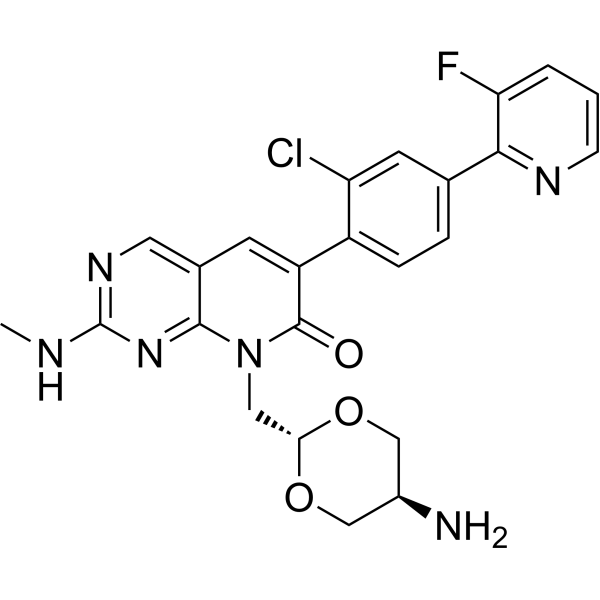Physicochemical Properties
| Molecular Formula | C24H22CLFN6O3 |
| Molecular Weight | 496.92 |
| Exact Mass | 496.142 |
| CAS # | 2750707-05-0 |
| PubChem CID | 162642759 |
| Appearance | White to off-white solid powder |
| LogP | 2.2 |
| Hydrogen Bond Donor Count | 2 |
| Hydrogen Bond Acceptor Count | 9 |
| Rotatable Bond Count | 5 |
| Heavy Atom Count | 35 |
| Complexity | 784 |
| Defined Atom Stereocenter Count | 0 |
| SMILES | C([C@H]1OC[C@@H](CO1)N)N1C(C(C2C=CC(C3N=CC=CC=3F)=CC=2Cl)=CC2=CN=C(N=C12)NC)=O |
| InChi Key | QKNBRNSGPNCARD-UHFFFAOYSA-N |
| InChi Code | InChI=1S/C24H22ClFN6O3/c1-28-24-30-9-14-7-17(16-5-4-13(8-18(16)25)21-19(26)3-2-6-29-21)23(33)32(22(14)31-24)10-20-34-11-15(27)12-35-20/h2-9,15,20H,10-12,27H2,1H3,(H,28,30,31) |
| Chemical Name | 8-[(5-amino-1,3-dioxan-2-yl)methyl]-6-[2-chloro-4-(3-fluoropyridin-2-yl)phenyl]-2-(methylamino)pyrido[2,3-d]pyrimidin-7-one |
| HS Tariff Code | 2934.99.9001 |
| Storage |
Powder-20°C 3 years 4°C 2 years In solvent -80°C 6 months -20°C 1 month |
| Shipping Condition | Room temperature (This product is stable at ambient temperature for a few days during ordinary shipping and time spent in Customs) |
Biological Activity
| Targets | SIK1 SIK2 SIK3 |
| ln Vitro | MRIA9 (5 μM) MRIA9 causes significant apoptosis, which makes SKOV3 cells more susceptible to paclitaxel treatment[1]. In HeLa cells, MRIA9 (5 μM) combined with paclitaxel (2 nM) greatly increases cell death[1]. MRIA9 significantly impairs centrosome function, misplaces the spindles during mitosis in ovarian cancer cell lines, stops the centrosome from disjunction in the late G2 phase, and makes patient-derived 3D-spheroids and ovarian cancer cells more sensitive to paclitaxel treatment[2]. |
| ln Vivo | High oral bioavailability (F = 75-80%) is demonstrated by MRIA9[1]. |
| Cell Assay |
Cell Viability Assay[1] Cell Types: SKOV3 cells. Tested Concentrations: 0.5-5 μM (1 nM paclitaxel). Incubation Duration: 9 days. Experimental Results: Inhibited cell growth. |
| References |
[1]. Structure-Based Design of Selective Salt-Inducible Kinase Inhibitors. J Med Chem. 2021 Jun 24;64(12):8142-8160. [2]. The Small-Molecule Inhibitor MRIA9 Reveals Novel Insights into the Cell Cycle Roles of SIK2 in Ovarian Cancer Cells. Cancers 2021, 13(15), 3658. |
Solubility Data
| Solubility (In Vitro) | DMSO : 66.67 mg/mL (134.17 mM) |
| Solubility (In Vivo) |
Solubility in Formulation 1: 5 mg/mL (10.06 mM) in 10% DMSO + 90% Corn Oil (add these co-solvents sequentially from left to right, and one by one), clear solution; with sonication. For example, if 1 mL of working solution is to be prepared, you can add 100 μL of 50.0 mg/mL clear DMSO stock solution to 900 μL of corn oil and mix evenly. Solubility in Formulation 2: ≥ 4.5 mg/mL (9.06 mM) (saturation unknown) in 10% DMSO + 90% (20% SBE-β-CD in Saline) (add these co-solvents sequentially from left to right, and one by one), clear solution. For example, if 1 mL of working solution is to be prepared, you can add 100 μL of 45.0 mg/mL clear DMSO stock solution to 900 μL of 20% SBE-β-CD physiological saline solution and mix evenly. Preparation of 20% SBE-β-CD in Saline (4°C,1 week): Dissolve 2 g SBE-β-CD in 10 mL saline to obtain a clear solution. (Please use freshly prepared in vivo formulations for optimal results.) |
| Preparing Stock Solutions | 1 mg | 5 mg | 10 mg | |
| 1 mM | 2.0124 mL | 10.0620 mL | 20.1240 mL | |
| 5 mM | 0.4025 mL | 2.0124 mL | 4.0248 mL | |
| 10 mM | 0.2012 mL | 1.0062 mL | 2.0124 mL |
